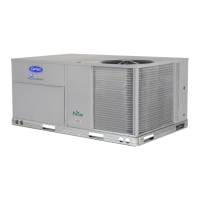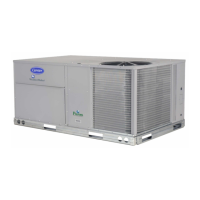50
VAV Cool Mode Selection during the Occupied Period
(C.TYP = 1,2 and Operating Modes
MODE
OCC =ON)
There is no difference in the selection of a cooling mode for ei-
ther VAV-RAT or VAV-SPT in the occupied period. The actual
selection of a cool mode, for both control types, is based upon
the controlling return-air temperature (Temperatures
AIR.T
CTRL
R.TMP). Typically this is the same as the re-
turn air temperature thermistor (Temperatures
AIR.T
RAT) except when under CCN Linkage.
Cool Mode Determination
If the machine control type (Configuration
UNIT
C.TYP)
= 1 (VAV-RAT) or 2 (VAV-SPT) and the control is occupied
(Operating Modes
MODE
OCC=ON), then the unit will
not follow the occupied cooling set point (OCSP). Instead, the
control will follow two offsets in the determination of an occu-
pied VAV cooling mode (Setpoints
V. C . O N and Setpoints
V. C . O F ), applying them to the low-heat off trip point and com-
paring the resulting temperature to the controlling return tem-
perature (R.TMP).
The Setpoints
V. C . O N (VAV cool mode on offset) and Set-
points
V. C . O F (VAV cool mode off offset) offsets are used in
conjunction with the low heat mode off trip point to determine
when to bring cooling on and off and in enforcing a true “vent”
mode between heating and cooling. See Fig. 5. The occupied
cooling set point is not used in the determination of the cool
mode. The occupied cooling set point is used for supply air re-
set only.
Fig. 5 — VAV Occupied Period Trip Logic
The advantage of this offset technique is that the control can
safely enforce a vent mode without worrying about crossing set
points. Even more importantly, under CCN linkage, the occu-
pied heating set point may drift up and down. As such, this
technique of using offsets ensures a guaranteed separation in
degrees F between the calling out of a heating or cooling mode
at all times.
VAV Occupied Cool Mode Evaluation Configuration
There are VAV occupied cooling offsets under Setpoints.
NOTE: There is a sub-menu at the local display (Run Status
TRIP) that allows the user to see the exact trip points for both the
heating and cooling modes without having to calculate them. Re-
fer to the Cool Mode Diagnostic Help section on page 51 for more
information.
To enter into a VAV Occupied Cool mode, the controlling tem-
perature must rise above [OHSP minus L.H.ON plus L.H.OF
plus V. C . O N ].
To exit out of a VAV Occupied Cool Mode, the controlling
temperature must fall below [OHSP minus L.H.ON plus
L.H.OF plus V. C . O N minus V. C . O F ].
NOTE: With vent mode, it is possible to exit out of a cooling
mode during the occupied period if the return-air temperature
drops low enough. When supply-air temperature reset is not con-
figured, this capability will work to prevent over-cooling the space
during the occupied period.
Supply Air Set Point Control and the Staging of Compressors
Once the control has determined that a cooling mode is in ef-
fect, the cooling control point (Run Status
VIEW
CL.C.P)
is calculated and is based upon the supply air set point (Set-
points
SASP) plus any supply air reset being applied (In-
puts
RSET
SA.S.R).
Refer to the SumZ Cooling Algorithm section on page 52 for a
discussion of how the P Series ComfortLink controls manage
the staging of compressors to maintain supply-air temperature.
VAV Cool Mode Selection during the Unoccupied Period
(C.TYP = 1,2; Operating Modes
MODE
OCC=OFF) and
Space Sensor Cool Mode Selection (C.TYP=4)
The machine control types that utilize this technique of mode
selection are:
• C.TYP = 1 (VAV-RAT) in the unoccupied period
• C.TYP = 2 (VAV-SPT) in the unoccupied period
• C.TYP = 4 (SPT-MULTI) in both the occupied and unoc-
cupied period
These particular control types operate differently than the VAV
types in the occupied mode in that there is both a LOW COOL
and a HIGH COOL mode. For both of these modes, the control of-
fers two independent set points, Setpoints
SA.LO (for LOW
COOL mode) and Setpoints
SA.HI (for HIGH COOL mode).
The occupied and unoccupied cooling set points can be found
under Setpoints.
The heat/cool set point offsets are found under Configuration
D.LV.T. See Table 36.
Table 36 — Cool/Heat Set Point Offsets Configuration
ITEM EXPANSION RANGE UNITS
CCN
POINT
DEFAULT
V.C.ON VAV Occ.
Cool On Delta
0 to 25 deltaF VAVOCON 3.5
V.C.OF VAV Occ.
Cool Off Delta
1 to 25 deltaF VAVOCOFF 2
L.H.OF
DMDLHOFF
L.H.ON
DMDLHON
V.C. ON
VAVOCON
V.C. OF
VAVOCOFF
OHSP
ITEM EXPANSION RANGE UNITS
CCN
POINT
DEFAULT
OCSP Occupied
Cool Setpoint
55 to 80 dF OCSP 75
UCSP Unoccupied
Cool Setpoint
75 to 95 dF UCSP 90
ITEM EXPANSION RANGE UNITS CCN POINT DEFAULT
D.LV.T COOL/HEAT SETPT. OFFSETS
L.H.ON Dmd Level Lo Heat On –1 to 2 ^F DMDLHON 1.5
H.H.ON Dmd Level(+) Hi Heat On 0.5 to 20.0 ^F DMDHHON 0.5
L.H.OF Dmd Level(-) Lo Heat Off 0.5 to 2.0 ^F DMDLHOFF 1
L.C.ON Dmd Level Lo Cool On –1 to 2 ^F DMDLCON 1.5
H.C.ON Dmd Level(+) Hi Cool On 0.5 to 20.0 ^F DMDHCON 0.5
L.C.OF Dmd Level(-) Lo Cool Off 0.5 to 2 ^F DMDLCOFF 1
C.T.LV Cool Trend Demand Level 0.1 to 5 ^F CTRENDLV 0.1
H.T.LV Heat Trend Demand Level 0.1 to 5 ^F HTRENDLV 0.1
C.T.TM Cool Trend Time 30 to 600 sec CTRENDTM 120
H.T.TM Heat Trend Time 30 to 600 sec HTRENDTM 120

